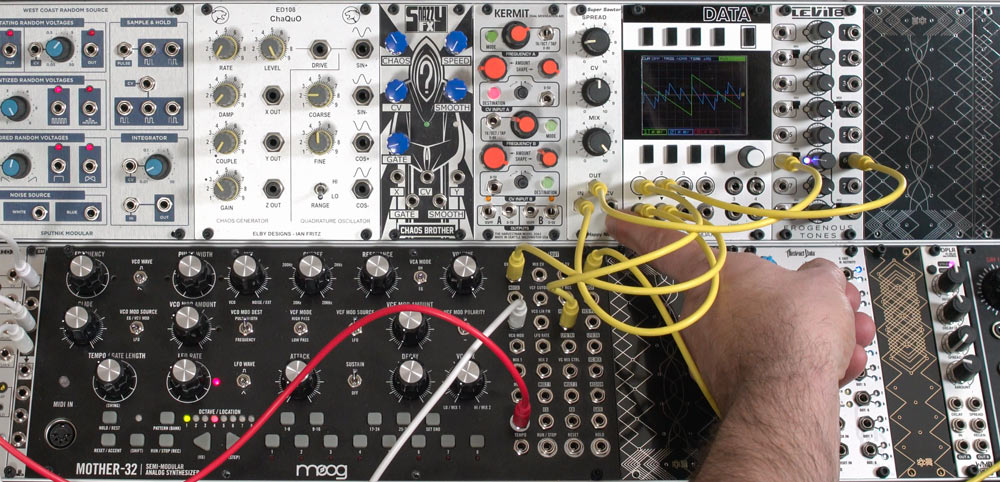Many semi-modular synths – such as the popular Moog Mother-32 – have just one VCO (voltage controlled oscillator). They usually feature a square wave with pulse width animation, but if you want to use the sawtooth wave instead, the sound can be rather static unless you put a lot of work into animating the filter and amplifier.
Therefore, a common addition to a semi-modular like the Mother-32 is a second oscillator. This allows you to create the classic detuned, chorused sound, as well as tune the two oscillators to octaves or intervals while still playing one note at a time.
An interesting alternative is to add a “waveform animator.” These usually take the input waveform – often a sawtooth, but in practice you can try almost anything other than a pulse or square – and create several phase shifted versions of it, with internal LFOs modulating the shift. This creates the sound of several oscillators in unison yet slightly (or drastically) detuned. Some may recognize this sound as the “supersaw” featured in several Roland synths, including the JP8000 and 8080 as well as their System 1.
In the following video I demonstrate patching both alternatives using a Moog Mother-32, Expert Sleepers Disting for the second oscillator – it has a nice, fat sawtooth – and a Happy Nerding Super Sawtor. (The concepts are the same if you have a different semi-modular synth, or waveform animator.)
In the video, I point out the usefulness of being able to invert the phase of audio signals in a modular patch (I used one channel of the Erogenous Tones LEVIT8 in the movie) – particularly this one. The output of the Super Sawtor is synced to the wave coming into it, but the base wave is inverted compared to the original. You can use the Sawtor’s output as is (it has its own original vs. shifted mix control), blend it with the source waveform to cancel out the fundamental wave and emphasize the phase shifted waves, or invert the Sawtor’s output to reinforce the fundamental wave coming from the oscillator. This is particularly useful when you mix the Sawtor’s output with a different waveform from the source oscillator, as it will different harmonics to cancel and reinforce.

- The Sawtor is rather dependent on the level of the incoming wave. You can try attenuating the input wave to “starve” the Sawtor, causing it to glitch and cut out. Or, you can boost the incoming wave to change the character of the Sawtor’s final mix.
- You should definitely try other simple waveforms such as a triangle or sine wave fed into the Super Sawtor. I think I actually prefer the “super triangle” sound over the sawtooth – it’s still hollow, but very full. A sine wave through it also sounds good; the Sawtor works like a soft derivative of a wavefolder, adding some zig-zags around the zero crossing. More complex waves can quickly turn into hash.
By the way: The godfather of this waveform animation trick is Bernie Hutchins, who published an article and circuit for it in Electronotes #87 back in 1978. Most of the animators available are derived from this idea. He also wrote an AES report on the subject, as well as a 2016 update called Waveshaping – Static and Dynamic. Considering that the Super Sawtor (which deviate a bit from the Electronotes design, and therefore sounds a bit different with features like a Spread control) lists for $165 and that most of the other Hutchins-derived animators go for under $100, they’re definitely a consideration if you want to fatten up the sound of your semi-modular synth. (And still get a second VCO, too – it will give you more tuning flexibility and potentially more waveforms to choose from.)


Awesome new tutorial. I now have a Sawtor on my ModularGrid shopping list 🙂
What brand are those patch cables you use? I’m very new to modular, but the cables I have gotten so far always come (and stay) kinked to some degree and are stiff. The ones you are using seem to be rather nice to work with.
Also… I love your tutorials, and the Lynda course was so helpful to me getting my head around the basic concepts of modular. Thank you!
I’m using Black Market Modular cables (http://www.blackmarketmodular.com/#cables). After having a mishmash of different brands, I did some research and found they have a slightly heavier gauge wire than some others with slim connectors for tight spots in compact modules. You’ll see on their page that they pride themselves on not having kinks in their cables.
And thank you for the kind words on the videos! I have three more courses coming out on Lynda.com over the next couple of months, and then I’m going to start a weekly video series here.
Great blog post, Chris … I’m learning a lot from lurking on your website. I’ve added an EricaSynths Wavetable VCO to my M-32 set-up because I liked the very different nature of sound I can get out of it, as opposed to the classic moog oscillator sound. Should be an interesting journey … I hope to have all 104HP filled by the end of the year.
I’m curious to hear how you like the Erica Wavetable VCO with the Mother – I’ve heard very good things about it from others, and have thought about getting one myself.
If you need help filling that 104hp (smile), I wrote an article elsewhere on the site about expanding the Mother: https://learningmodular.com/the-eurorack-expansion-host-rack/